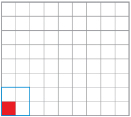Module 4
1. Module 4
1.29. Page 2
Module 4: Area
Get Started
In the following Try This activity you will examine how changing the length of the sides of a square affects the square’s perimeter and area. Do you need a review before getting started? If so, you can review perimeter in Lesson 1 of Module 3; and you can review area in Lessons 1 to 3 of this module.
You will need a copy of Quarter-Inch Grid paper or use the demonstration applet “Perimeter and Area (Rectangle)”
 Try This
Try This
Remember that you are looking at changes in area and perimeter as you change the size of the square.
Step 1: Make a square that has sides of one unit; in other words, a square that is 1 × 1. You can do this either on the grid paper or using the applet.
If using the applet, change the length by moving the “l” slider. You see the results in both the diagram and in the grey display area at the top of the applet. Change the width by moving the “w” slider.
Step 2: Measure the perimeter and area of the square. Then record the measurements in the table “Perimeter and Area of Squares,” also shown in Step 4. Remember to save the table in your course folder.
Step 3: Make more squares, increasing the side by 1 each time (as indicated in the Perimeter and Area of Squares table). If you are using the grid paper, samples of 1 × 1 and 2 × 2 squares follow.

Step 4: Complete the table; then answer the Try This questions. The first two rows are completed for you.
Perimeter and Area of Squares
|
1 |
2 |
3 |
4 |
5 |
6 |
|
Length of a Side in Units |
Dimensions of Square |
Perimeter in Units |
perimeter of square perimeter of 1 × 1 square |
Area in Units2 |
area of square area of 1 × 1 square |
|
1 |
s = 1 |
4 |
|
1 |
|
|
2 |
s = 2 |
8 |
|
4 |
|
|
3 |
s = 3 |
|
|
|
|
|
4 |
|
|
|
|
|
|
5 |
|
|
|
|
|
|
6 |
|
|
|
|
|
When you are done, place your answers in your course folder.
Think of the 1 × 1 square as your starting point.
TT 1. How much larger is the perimeter of the square with a length of 3 than the original 1 × 1 square?
TT 2. How much larger is the area of the square with a length of 3 than the original 1 × 1 square?
TT 3. Based on the trend you have noticed in this table, if you made the sides of a square 7 times as long, how would the perimeter of the square change?
TT 4. If you made the sides of a square 7 times as long, how would the area of the square change?
TT 5. If you made the sides of a square k times as long, how would the perimeter of the square change?
TT 6. If you made the sides of a square k times as long, how would the area of the square change?
 Share
Share
Based on the Try This activity you just completed, discuss the following questions with a partner or in a group.
- What trends did you observe in the table?
- As the square side length changes, how does this change the perimeter and area?
- Did you only look at the data from the top of the chart down (smaller to larger)?
- Did you consider how things changed when the size decreased (from the bottom of the chart up)?
- Suppose the side length of a square is doubled, which is affected more—the perimeter or the area?
Summarize your discussion and place a copy in your course folder.